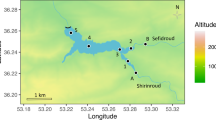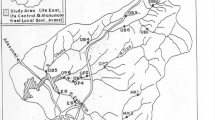Abstract
The evaluation of Tiber River quality, in a stretch including a sewage treatment plant, has been carried out by the contemporary evaluation of water effect on Daphnia and benthic macroinvertebrates community structure. To achieve a good status of a river water by the end of 2015, as provided in the Water Framework Directive (WFD) 2000/60/EC, is necessary to know the quality starting point. To this end, several endpoints are expected by the WFD, including Daphnia toxicity test and macroinvertebrate community analysis.
River water sampling was conducted in the four seasons, from upstream to downstream a sewage treatment plant. I endpoint. At the outfall of the sewage treatment plant, river water showed very high acute toxicity to Daphnia only in summer; some toxic effect can be found also upstream in spring. Results at the outfall were consistent with the hypothesis that disinfectants, mainly used in summer to treat discharging waters, are responsible of river water acute toxicity: Daphnia tests with each disinfectant (NaClO, PAA, ClO2) showed high toxicity.
River waters were also utilized in Daphnia reproduction tests. Samples at the outfall (excluding the summer one, undoubtedly toxic) caused slight reduction in survival and fecundity. Disinfectants were also checked in reproduction tests. Still at NOEC24h, they caused a significant toxicity on both death rate and reproduction.
II endpoint. Macroinvertebrate benthic community composition was evaluated upstream and downstream the sewage treatment plant, on these data Extended Biotic Index (EBI), was determined to get a score as quality class. A reduction of water quality score was found downstream the plant, one season delayed (autumn) respect the acute test on Daphnia.
Effect of disinfectant discharge, river dilution capability on a short spatial scale and use of different endpoints are discussed in term of river stretch quality.
Similar content being viewed by others
References
Banchetti, R., Marsili, D., & Galleni, L. (2004). Ecological modelling: from the biosphere to the everyday data gathering; filling the gap. Rivista di Biologia, 97(3), 469–82
Blatchley, E. R. III, Hunt, B. A., Duggirala, R., Thompson, J. E., Zhao, J., Halaby, T., Cowger, R. L., Straub, C. M., & Alleman, J. E. (1997). Effects of disinfectants on wastewater sediment toxicity, Water Research, 31(7), 1581–1588
Boyle, T. P., Smillie, G. M., Anderson, J. C., & Beeson D. R. (1990). A sensitivity analysis of nine diversity and seven similarity indices, Journal – Water Pollution Control Federation, 165(62), 749–762
Brack, W., Altenburger R., Ensenbach, U., Moder, E., Segner, H., & Schuurmann, G. (1999). Bioassay-Directed Identificatio of Organic Toxicants in River Sediment in the Industrial Region of Bitterfeld (Germany)–-A Contribution to Hazard Assessment. Archives of Environment Contamination and Toxicology, 37, 164–174
Brungs, W. A. (1973). Effects of residual chlorine on aquatic life. Journal - Water Pollution Control Federation, 45, 2180–2193
Buschini, A., Martino, A., Gustavino, B., Monfrinotti, M., Poli, P., Rossi, C., Santoro, M., & Rizzoni, M. (2001, September). Genotoxicity detected with comet assay and micronucleus test in Cyprinus carpio specimens exposed in situ to Trasimeno Lake waters treated with disinfectants for potabilisation. (Paper presented at the 30th Annual Meeting of the European Environmental Mutagen Society, Gant)
Campaioli, S., Ghetti, P. F., Minelli, A., & Ruffo, S. (1994). Manuale per il riconoscimento dei macroinvertebrati delle acque dolci italiane, Vol. 1. (Provincia Autonoma di Trento: Museo di Storia Naturale di Trento)
Chen, C. M., Shih, M. L., Lee, S. Z., & Wang, J. S. (2001). Increased toxicity of textile effluents by a chlorination process using sodium hypochlorite. Water Science & Technology, 43(2), 1–8
Emmanuel, E., Keckc, G., Blanchardb, J. M., Vermandeb, P., & Perrodina Y. (2004). Toxicological effects of disinfections using sodium hypochlorite on aquatic organisms and its contribution to AOX formation in hospital wastewater. Environment international, 30, 891–900
EPS 1/RM/11 Environment Canada. (1990). Biological Test Method: Acute lethality Test Using Daphnia spp. Reference Method Report EPS 1/RM/11, July 1990. (Ottawa: Environment Canada)
Ferraris, M., Chiesara, E., Radice, S., Giovara, A., Frigerio, S., Fumagalli, R., & Marabini, L. (2005). Study of potential toxic effects on rainbow trout hepatocytes of surface water treated with chlorine or alternative disinfectants. Chemosphere, 60, 65–73
Finney, D. J. (1947). Probit Analysis, a statistical treatment of the sigmoid response curve. (Cambridge: University of Cambridge, England)
Fisher, D. J., & Burton, D. T. (1993). The acute effects of continuous and intermittent application of chlorine dioxide and chlorite on Daphnia magna, Pimepales promelas, and Oncorhynchus mykiss. WREC-93-B4, University of Maryland, Wye Research and Education Center, Queenstown, MD.
Fisher, D. J., Burton, D. T., Yonkos, L. T., Turley, S. D., Turley, B. S., Ziegler, G. P., & Zillioux, E. J. (1994). Acute and short-term chronic effects of continuous and intermittent chlorination on Mysidiopsis bahia and Menidia beryllina. Environmental Toxicology & Chemistry, 13, 1525–1534
Ghetti, P. F. (1986). I macroinvertebrati nell’analisi di qualita dei corsi d’acqua. Manuale di applicazione. Indice Biotico: E.B.I. modificato. (Trento: Provincia Autonoma di Trento)
Guhl, W. (1987). Aquatic ecosystem characterisation by biotic indices. International Revue der Gesamten Hydrobiologie, 72, 431–455.
Hall, L. W., Helz, G. R., & Burton, D. T. (1981). Power Plant Chlorination: A Biological and Chemical Assessment. (USA: Ann Arbor, MI)
IRSA.(1993). Saggi di tossicità con Daphnia magna. Quaderno 1.1–9.11
IRSA-CNR. (1994). Metodi analitici per le acque. Poligrafico dello Stato. Quaderno, 100, 336–342.
Isidori, M., Lavorgna, M., Nardelli, A., & Parrella, A. (2004). Integrated environmental assessment of Volturno River in South Italy, Science of the Total Environment, 327, 123–134
Lydy, M. J., Crawford, C. G., & Frey, J. W. (2000). A comparison of selected diversity, similarity and biotic indices for detecting changes. Archives of Environment Contamination and Toxicology, 39, 469–479
Mancini, L., & Arcà, G. (2000). Carta della qualità biologica dei corsi d’acqua della Regione Lazio. (Roma: ISS – Regione Lazio, Il Centro Cromografico)
Mattei, D. (2002). Valutazione ecotossicologica dei disinfettanti per le acque: determinazioni sul campo (fiume Tevere) e indagini di laboratorio. Degree thesis, University of “Tor Vergata”, Rome
Mattei, D., Mancini, L., Migliore, L., Tancioni, L., & Cataudella S. (2005). Effetti di un impianto di depurazione sul fiume Tevere: tossicità su Daphnia e qualità biologica delle acque. Biologia Ambientale 19(1), 123–130
Monarca, S., Feretti, D., Collivignarelli, C., Guzzella, L., & Zerbini, I. (2000). The influence of different disinfectants on mutagenicity and toxicity of urban wastewater. Water Research, 34(17), 4261–4269
OECD. (1996). OECD Guidelines for Testing of Chemicals. Procedure 211 – Daphnia magna reproduction test. (Paris: France)
Pinder, L. C. V., Ladle, M., Gledhill, T., Bass, J. A. B., & Matthews, A. M. (1987). Biological surveillance of water quality. A comparison of macroinvertebrate surveillance methods in relation to assessment of water quality in a chalk stream. Hydrobiology, 109(2), 207–226
Prat, N., & Munné, A. (2000). Water use and quality and stream flow in a Mediterranean stream. Water Research, 34(15), 3876–3881
Rook, J. J. (1974). Formation of haloforms during chlorination of natural waters. Water Treatment and Examination, 23, 234–243
Ruffo, S. (Ed.). (1977–85). Guide per il riconoscimento delle specie animali delle acque interne italiane. (Rome: Collana del Progetto Finalizzato “Promozione della Qualità dell’Ambiente”, CNR)
Sanna, M., & Floccia, M. (1993). Il Tevere alle porte di Roma. Rapporto sullo stato di salute. (Vizzolo Predabissi (Mi): Ecoedizioni)
Sansoni, G. (1988). Atlante per il riconoscimento dei macroinvertebrati dei corsi d’acqua italiani. (Provincia Autonoma di Trento: Centro Italiano Studi di Biologia Ambientale)
Sorace, A., Formichetti, P., Boano, A., Andreani, P., Gramegna, C., & Mancini, L. (2002). The presence of a river bird, the dipper, in relation to water quality and biotic indices in central Italy. Environmental Pollution, 118, 89–96
Vandenberghe, V., Goethals, P. L. M., Van Griensven, A., Meirlaen, J., De Pauw, N., Vanrolleghem, P., & Bauwen, W. (2005). Application of automated measurement stations for continuous water quality monitoring of the Dender River in Flanders, Belgium. Environmental monitoring and assessment, 108, 85–98
Veschetti, E., Cutilli, D., Bonadonna, L., Briancesco, R., Martini, C., Cecchini, G., Anastasi, P., & Ottaviani, M. (2003). Pilot-plant comparative study of peracetic acid and sodium hypochlorite wastewater disinfection. Water Research, 37, 78–94
Viganò, L., Arillo, A., Buffagni, A., Camusso, M., Ciannarella, R., Crosa, G., Falugi, C., Galassi, S., Guzzella, L., Lopez, A., Mingazzini, M., Pagnotta, R., Patrolecco, L., Tartari, G., & Valsecchi, S. (2003). Quality assessment of bed sediments of the Po River (Italy). Water Research, 37, 501–518.
Washington, H.G. (1984). Diversity, biotic and similarity indices. Water Research 18, 653–694.
White, G. C. (1986). Handbook of Chlorination, II Ed. (New York: Van Nostrand Reinhold)
WHO. (2000). Disinfectants and disinfectant by-products. Environmental Health Criteria 216. (Geneva: WHO)
Woodiwiss, F. S. (1981). Biological Water Assessment Methods, Nottingham-Abriged Report of Working Group Expert (ENV/416/80). Commission of the European Community
Yonkos, L. T., Fisher, D. J., Burton, D. T., Whitekettle, W. K., & Petrille, J. K. (2001). Effectiveness of the Sulphur(IV) compound, sodium bisulphite, in reducing Chlorine, Chorine dioxide, and Chlorite toxicity to Daphnia magna in well and pond water. Environmental Toxicology and Chemistry, 20(3), 530–536
Author information
Authors and Affiliations
Corresponding author
Rights and permissions
About this article
Cite this article
Mattei, D., Cataudella, S., Mancini, L. et al. Tiber River Quality in the Stretch of a Sewage Treatment Plant: Effects of River Water or Disinfectants to Daphnia and Structure of Benthic Macroinvertebrates Community. Water Air Soil Pollut 177, 441–455 (2006). https://doi.org/10.1007/s11270-006-9183-1
Received:
Accepted:
Published:
Issue Date:
DOI: https://doi.org/10.1007/s11270-006-9183-1




